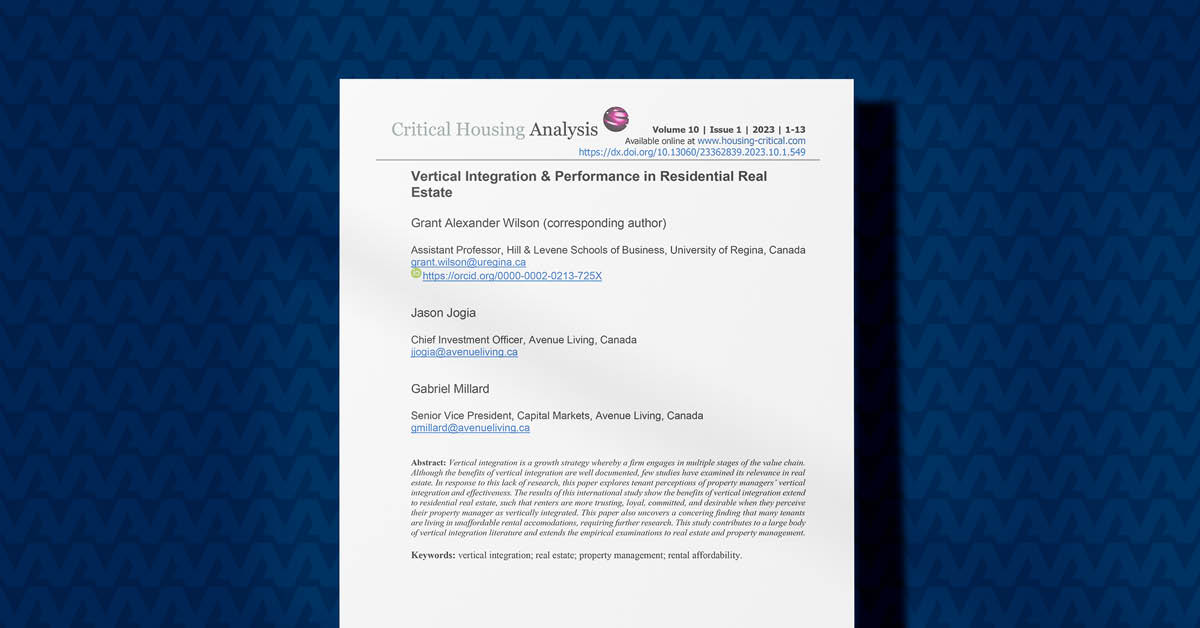Authors
Grant Alexander Wilson, Ph.D., Assistant Professor, Faculty of Business Administration, University of Regina
Jason Jogia, MBA, M.Fin., Chief Investment Officer, Avenue Living
Author Bios
Dr. Wilson is an Assistant Professor at the Hill and Levene School of Business, University of Regina. His research focuses on marketing, strategy, and innovation. He has published over 20 peer-reviewed articles in top management journals including Journal of Small Business Management, Research-Technology Management, and Journal of Business Strategy. His research has been featured in the National Post and by the World Economic Forum. Dr. Wilson is also a research consultant and contributor to Avenue Living Asset Management.
Mr. Jogia is the Chief Investment Officer at Avenue Living and has over 15 years of experience in real estate capital markets, originating over $10 billion in real estate loans and $1 billion in equity. He has extensive experience in real estate investment analysis and capital structure across various real estate classes. In addition to holding 2 Masters’ degrees in Finance, Mr. Jogia is pursuing his Doctorate of Business Administration and currently serves as an instructor at the University of Calgary, specializing in real estate finance.
INTRODUCTION
Diversification is synonymous with “not putting all your eggs in one basket.” If the basket drops, all of the eggs break. Therefore, placing eggs in multiple baskets – the act of diversifying – reduces such risk. The concept of diversification has a long history in finance and portfolio management (Markowitz, 1952). Diversification is a strategy that aims to reduce risk through the inclusion of multiple and differing investments. “The rationale behind this technique is that a portfolio constructed of different kinds of assets will, on average, yield higher long-term returns and lower the risk of any individual holding or security” (Segal, 2021). This paper first explores modern portfolio theory, the mechanics of how diversification reduces risk. Next, it examines the importance of diversifying portfolios with real estate investments and diversification within real estate portfolios for institutional investors. Last, the paper explores the limitations of diversification and advantages of specialization for small real estate owners/operators. It concludes by offering strategic directives for real estate investors.
MODERN PORTFOLIO THEORY
Developed 70 years ago by economist Harry Markowitz, modern portfolio theory can hardly be considered “modern.” Despite its age, modern portfolio theory’s relevance is timeless, as it offers a framework for designing portfolios that maximize return and minimize risk (McClure, 2021). According to Markowitz (1952), an investment’s risk comprises systematic and unsystematic risks. “A systematic risk is one that influences a large number of assets, each to a greater or lesser extent” (Ross et al., 2007). Systematic risks are also called market risks (e.g., recession) and cannot be eliminated by diversification (McClure, 2021). Conversely, “an unsystematic risk is one that affects a single asset or small group of assets” (Ross et al., 2007). Unsystematic risks are also known as asset-specific risks (e.g., supply shortage of a company’s input) and can be reduced through diversification. Markowitz (1952) argues that overall portfolio risk can be reduced to a certain point by diversification, as the inclusion of investments that do not move proportionally in the same direction at the same time eliminate unsystematic risk (Figure 1).
FIGURE 1 – MODERN PORTFOLIO THEORY

Sources: McClure (2021), & Ross et al. (2007)
Although modern portfolio theory was quickly and heavily embraced in the stock and bond markets, its application to real estate was much slower (Viezer, 2010). Only in the 1980s were diversification and modern portfolio theory applied to real estate. Today, savvy investors both diversify portfolios to include real estate and diversify within real estate investment portfolios.
DIVERSIFYING WITH REAL ESTATE
Miles and McCue (1984) were the first to show that real estate investments were significantly correlated with inflation, providing support for real estate as an investment hedge. Miles and McCure’s (1984) findings are highly relevant today, as recent examinations show that capital appreciation of real estate assets outpaces inflation (Wilson, 2021). Researchers have also shown that real estate investments have low correlations with stocks and bonds (Miles & McCue, 1982; Miles & McCue, 1984; Robichek et al., 1972; Viezer, 2010; Zerbst & Cambon, 1984), making them ideal for diversification (Markowitz, 1952; Ross et al., 2007).
The question of how much real estate to include in an investment portfolio has been widely debated (Firstenberg et al., 1988; Fogler, 1984; Giliberto, 1992; Hartzell, 1986; Irwin & Landa, 1987; Kallberg et al., 1996; Webb et al., 1988; Webb & Rubens, 1987; Viezer, 2010; Ziobrowski & Ziobrowski, 1997). Hartzel (1986) recommended smaller real estate investment allocations, such as 3% to 11%. Kallberg et al. (1996) and Giliberto (1992) offered similar recommendations of 10%. Firstenberg et al. (1988), Folger (1984), and Irwin and Landa (1987) argued that portfolios required 15% to 20% of real estate investments to achieve maximum diversification benefits. Ziobrowski & Ziobrowski (1997) concluded that 20% to 30% of an investment portfolio was necessary to realize the greatest return. Others have suggested that the majority of one’s portfolio should be comprise of real estate investments (Webb et al., 1988; Webb & Rubens, 1987). Despite the contrasting empirical evidence, research overwhelmingly supports the inclusion of real estate in portfolios to reduce risk and increase return (Viezer, 2010).
To illustrate, an examination of changes to home prices, land values, stocks, and bonds illustrates the benefits of Canadian real estate (Figure 2).
FIGURE 2 – ANNUAL CHANGES TO CANADIAN REAL ESTATE, STOCKS, & BONDS

Sources: Bank of Canada (2022), Farm Credit Canda (2021), Statistics Canada (2022), Yahoo Finance (2022)
The new house price index – a measure to assess changes to home prices in Canada – has shown consistency and strong year-over-year appreciations, particularly from 2019 to 2021 (Statistics Canada, 2022). Annual changes to Canadian farmland values have also been favorable and consistent, ranging from 4% to 8% in the period examined (Farm Credit Canada, 2021). In contrast, the S&P/TSX composite – the benchmark Canadian stockmarket index – has shown double-digit returns but also extreme volatility from 2016 to 2021 (Yahoo Finance, 2022). Over the last several years, Canada’s 10-year government bond has offered stability, but at the expense of nominal returns (Bank of Canada, 2022).
The risk and return benefits of real estate – demonstrated by past empirical examinations and in the above depiction – emphasize the need to include real estate in investment portfolios for diversification. According to Viezer (2010), “first decide the optimal allocation of real estate to a multiasset portfolio, and then decide how to diversify within the real estate portfolio.”
DIVERSIFYING WITHIN REAL ESTATE
Researchers have debated the most effective means to diversify real estate portfolios, as unsystematic risk can be reduced by property type, geographic, and financial diversification (Anderson et al., 2015; Benefield et al., 2009; Campbell et al., 2003; Cici et al., 2011; Cronqvist et al., 2001; Gobbi & Sette, 2014; Gyourko & Nelling, 1996; Hartzell et al., 2014; Ioannidou & Ongena, 2010; Ro & Ziobrowski, 2011; Santos & Winton, 2008).
According to Miles and McCue (1982), property type diversification offers the greatest return and the lowest risk. This has been replicated in studies of real estate investment trusts (REITs). Benefield et al. (2009) and Row and Ziobrowski (2011) show that diversified REITs outperform specialized REITs. Anderson et al. (2015) corroborate these findings, showing that diversified REITs have a “strong positive relationship” with return on assets, return on equity, and Q ratios (market value to asset replacement cost). Anderson et al. (2015) explain that “the diversification benefit comes from both the ability to select better-performing property types in ‘hot’ markets and the limited exposure to poorly performing property types in ‘cold’ markets” (p. 48). In addition to property type diversification, diversifying with private or public REITs has its advantages. According to Blackstone (2022) and Wang (2021), private REITs generally increase in times of rising interest rates and have less volatility, as compared to public REITs. As such, unsystematic risk can be reduced by REIT type (e.g., public/private) and property type (Gyourko & Nelling, 1996).
There is a significant body of research that shows the benefits of geographic diversification (Campbell et al., 2003; Cici et al., 2011, Cronqvist et al., 2001; Feng et al., 2021; Hartzell et al., 2014; Jud et al., 2021; Oertel et al., 2019). Hartzell et al. (1987) argued that diversification based on geography was strategic, given the performance benefits. As with property type diversification, geographically diverse REITs have been shown to outperform geographically concentrated REITs. According to Feng et al. (2021), “geographic diversification is associated with higher REIT values for firms that can be described as being more transparent” (p. 267). Recent work by Jud et al. (2021) and Oertel et al. (2019) adds to such geographic diversification research, showing international acquisitions offer enhanced portfolio returns.
Grissom et al. (1987) acknowledged the performance benefits of diversifying by both property type and geography. In fact, this research showed that diversification “across markets and property type reduced unsystematic risk more than across just markets or across just property types” (Viezer, 2010). Accordingly, Grissom et al.’s (1987) research supported the combination of property type and geographic diversification to reduce risk and increase returns. A lesser-explored area of research suggests that financial diversification may also reduce unsystematic risk among real estate investments.
There is an inherent risk in concentrated borrowing. According to Gobbi and Sette (2014), in times of crisis concentrated borrowing is detrimental to a firm’s access to credit. Moreover, Ioannidou and Ongena (2010) find that interest rates increase for clients over time and companies can negotiate better deals in new relationships with different banks. Therefore, it is strategic for real estate companies to diversify their borrowing to reduce unsystematic risk and negotiate better interest rates.
It is evident that diversification with and within real estate (e.g., property type, geography, and financial diversification) is necessary to maximize returns and minimize risk, but can endless diversification reintroduce risks?
OVER-DIVERSIFICATION & SPECIALIZATION
When strategically executed, diversification is a proven method to reduce risk and increase return (Allison, 2021). However, it is possible to over-diversify. Investments that are not strategically motivated are unadvisable (Olgun, 2005), as they add unnecessary risk to the portfolio without the added upside (Allyson, 2021). Lynch (1989) coined this phenomenon of worsening the risk and return tradeoff of an investment portfolio by over-diversifying as “diworsification.” This paper argues that the real estate diversification and performance relationship is curvilinear, similar to other strategies (Bhuian et al., 2005; Oswald & Brettel, 2017; Tsai et al., 2008). While diversification is necessary to reduce risk and increase return, beyond a certain level it can become detrimental to portfolio performance (Figure 3).
FIGURE 3 – DIVERSIFICATION & PERFORMANCE RELATIONSHIP

Diversification is also not advisable for new or small owners/operators. According to Kenton (2022), a specialization strategy focuses on limited scope and expertise for greater efficiency and performance. Specialization has been shown to create economies of scale, improve market positions, and enhance the bottom line of small businesses (Intihar & Pollack, 2012; Williams et al., 2018; Wilson et al., 2020). New or small real estate owners/operators are more likely to benefit from a specialization versus diversification strategy, as eliminating unsystematic risk is unlikely due to the small number of properties, geographic concentration, and individual property management. As these new and small owners/operators mature and expand, a diversification strategy becomes more advantageous and reduces their accumulated unsystematic risk.
STRATEGIC DIRECTIVES
So how much real estate diversification is enough, and how much is too much? Diversification with and within real estate is necessary for investors. However, Olgun (2005), aptly states that non-strategic real estate investments are problematic and often produce “negative abnormal returns.” Instead, when real estate investments are strategically included in multi-asset portfolios they increase return and reduce unsystematic risk (Miles & McCue, 1982; Miles & McCue, 1984; Robichek et al., 1972; Viezer, 2010; Zerbst & Cambon, 1984). Diversification within real estate is also required to eliminate unsystematic risk and realize the greatest level of return (Grissom et al., 1987; Hartzell et al., 1987; Jud et al., 2021; Miles & McCue, 1982; Oertel et al., 2019, Viezer, 2010). As Grissom et al. (1987) suggest, the best results come from combined diversification methods (e.g., property type and geography). It is further argued that financial diversification can also help reduce unsystematic risk and lower borrowing costs. In the context of Canada, investment portfolios that include residential real estate and farmland as core assets appear to both enhance value and offer stability. Diversification within these real estate investment categories, such as the types of residential real estate and various Canadian sub-markets, are also likely to enhance the overall portfolio of investors. As Peter Bernstein, one of the most prominent American economists wrote, “diversification of risk matters not just defensively, but because it maximizes returns as well, because we expose ourselves to all of the opportunities that there may be out there.”
REFERENCES
Allison, D. (2021). Signs of overdiversification. Investopedia. https://www.investopedia.com/articles/financial-theory/11/signs-of-over-diversification.asp
Anderson, R. I., Benefield, J. D., & Hurst, M. E. (2015). Property-type diversification and REIT performance: an analysis of operating performance and abnormal returns. Journal of Economics and Finance, 39(1), 48-74.
Bank of Canada. (2022). Selected bond yields. https://www.bankofcanada.ca/rates/interest-rates/canadian-bonds/
Benefield, J. D., Anderson, R. I., & Zumpano, L. V. (2009). Performance differences in property‐type diversified versus specialized real estate investment trusts (REITs). Review of Financial Economics, 18(2), 70-79.
Bhuian, S. N., Menguc, B., & Bell, S. J. (2005). Just entrepreneurial enough: the moderating effect of entrepreneurship on the relationship between market orientation and performance. Journal of Business Research, 58(1), 9-17.
Blackstone. (2022). Why private real estate. https://www.breit.com/literature/
Campbell, R. D., Petrova, M., & Sirmans, C. F. (2003). Wealth effects of diversification and financial deal structuring: Evidence from REIT property portfolio acquisitions. Real Estate Economics, 31(3), 347–366.
Candelon, B., Fuerst, F., & Hasse, J. B. (2021). Diversification potential in real estate portfolios. International Economics, 166, 126-139.
Chakrabarti, A. K. (1990). Organizational factors in post-acquisition performance. IEEE Transactions on Engineering Management, 37(4), 259-268.
Chakrabarti, A. K., & Souder, W. E. (1987). Technology, innovation and performance in corporate mergers: A managerial evaluation. Technovation, 6(2), 103-114.
Chen, J. (2019). Diworsification. Investopedia. https://www.investopedia.com/terms/d/diworsification.asp
Cici, G., Corgel, J., & Gibson, S. (2011). Can fund managers select outperforming REITs? Examining fund holdings and trades. Real Estate Economics, 39(3), 455–486
Cronqvist, H., Hogfeldt, P., & Nilsson, M. (2001). Why agency costs explain diversification discounts. Real Estate Economics, 29(1), 85–126.
Farm Credit Canada. (2021). FCC farmland values report. https://www.fcc-fac.ca/en/knowledge/economics/farmland-values-report.html
Feng, Z., Pattanapanchai, M., Price, S. M., & Sirmans, C. F. (2021). Geographic diversification in real estate investment trusts. Real Estate Economics, 49(1), 267-286.
Firstenberg, P. M., Ross, S. A., & Zisler, R. C. (1988). Real estate: the whole story. Journal of Portfolio Management, 14(3), 22-33.
Fogler, H. R. (1984). 20% in real estate: can theory justify it? The Journal of Portfolio Management, 10(2), 6-13.
Friedman, H. C. (1971). Real estate investment and portfolio theory. Journal of Financial and Quantitative Analysis, 6(2), 861-874.
Giliberto, S. (1992). The allocation of real estate to future mixed-asset institutional portfolios. Journal of Real Estate Research, 7(4), 423-432.
Gobbi, G., & Sette, E. (2014). Do firms benefit from concentrating their borrowing? Evidence from the great recession. Review of Finance, 18(2), 527-560.
Grissom, T. V., Kuhle, J. L., & Walther, C. H. (1987). Diversification works in real estate, too. The Journal of Portfolio Management, 13(2), 66-71.
Gyourko, J., & Nelling, E. (1996). Systematic risk and diversification in the equity REIT market. Real Estate Economics, 24(4), 493-515.
Hartzell, D., Hekman, J., & Miles, M. (1986). Diversification categories in investment real estate. Real Estate Economics, 14(2), 230-254.
Hartzell, D., Shulman, D., & Wurtzebach, C. (1987). Refining the analysis of regional diversification for income-producing real estate. Journal of Real Estate Research, 2(2), 85-95.
Hartzell, J. C., Sun, L., & Titman, S. (2014). Institutional investors as monitors of corporate diversification decisions: Evidence from real estate investment trusts. Journal of Corporate Finance, 25, 61–72.
Intihar, A., & Pollack, J. M. (2012). Exploring small family‐owned firms’ competitive ability: Differentiation through trust, value‐orientation, and market specialization. Journal of Family Business Management, 2(1), 76-86.
Ioannidou, V. and Ongena, S. (2010). Time for a change: Loan conditions and bank behavior when firms switch banks. Journal of Finance, 65, 1847–1877.
Irwin, S. H., & Landa, D. (1987). Real estate, futures, and gold as portfolio assets. Journal of Portfolio Management, 14(1), 29.
Jud, D., Wingler, T., & Winkler, D. (2002). The integration of retail space markets. Journal of Real Estate Portfolio Management, 8(1), 79-92.
Kallberg, J. G., Liu, C. H., & Greig, D. W. (1996). The role of real estate in the portfolio allocation process. Real Estate Economics, 24(3), 359-377.
Kenton, W. (2022). Specialization. https://www.investopedia.com/terms/s/specialization.asp
Lynch, P. (1989). One up on Wall Street: How to use what you already know to make money in the market. Penguin Books.
Markowitz, H. (1952). Portfolio selection. The Journal of Finance, 7(1), 77-91.
McClure, B. (2021). Modern portfolio theory: Why it’s still hip. Investopedia. https://www.investopedia.com/managing-wealth/modern-portfolio-theory-why-its-still-hip/
Miles, M., & McCue, T. (1982). Historical returns and institutional real estate portfolios. Journal of the American Real Estate and Urban Economics Association, 10, 184-198.
Miles, M., & McCue, T. (1984). Diversification in the real estate portfolio. Journal of Financial Research, 7(1), 57-68.
Miles, M., Cole, R., & Guilkey, D. (1990). A different look at commercial real estate returns. Real Estate Economics, 18(4), 403-430.
Oertel, C., Gütle, T., Klisa, B., & Bienert, S. (2019). US real estate as target assets for European investors: New empirical evidence of diversification benefits. Journal of Property Investment & Finance.
Olgun, S. (2005). The performance of acquisitions in the real estate investment trust industry. Journal of Real Estate Research, 27(3), 321-342.
Oswald, M., & Brettel, M. (2017). A five-country study on the curvilinear performance consequences of responsive and proactive market orientation. In The customer is NOT always right? Marketing orientations in a dynamic business world. Springer.
Parrino, J. D., & Harris, R. S. (1999). Takeovers, management replacement, and post‐acquisition operating performance: some evidence from the 1980s. Journal of Applied Corporate Finance, 11(4), 88-96.
Ratcliffe, C., Dimovski, W., & Keneley, M. (2009). Consolidation within the Australian real estate investment trust sector: An evaluation of the impact on unitholder returns. Journal of Property Research, 26(4), 283-307.
Ro, S., & Ziobrowski, A. J. (2011). Does focus really matter? Specialized vs. diversified REITs. The Journal of Real Estate Finance and Economics, 42(1), 68-83.
Robichek, A. A., Cohn, R. A., & Pringle, J. J. (1972). Returns on alternative investment media and implications for portfolio construction. The Journal of Business, 45(3), 427-443.
Ross, S. A., Westerfield, R. W., Jordan, B. D., & Roberts, G. S. (2007). Fundamentals of corporate finance. McGraw-Hill Ryerson.
Roulac, S. E. (1981). How to structure real estate investment management. The Journal of Portfolio Management, 8(1), 32-35.
Santos, J. and Winton, A. (2008). Bank loans, bonds, and information monopolies across the business cycle. Journal of Finance, 63, 1315–1359.
Segal, T. (2021). Diversification. Investopedia. https://www.investopedia.com/terms/d/diversification.asp
Statistics Canada. (2022). New housing price index, monthly. https://www150.statcan.gc.ca/t1/tbl1/en/tv.action?pid=1810020501&pickMembers%5B0%5D=1.1&cubeTimeFrame.startMonth=12&cubeTimeFrame.startYear=1989&cubeTimeFrame.endMonth=12&cubeTimeFrame.endYear=2020&referencePeriods=19891201%2C20201201
Tsai, K. H., Chou, C., & Kuo, J. H. (2008). The curvilinear relationships between responsive and proactive market orientations and new product performance: A contingent link. Industrial Marketing Management, 37(8), 884-894.
Viezer, T.W. (2010). The application of modern portfolio theory to real estate: A brief survey. In Guerard, J.B. (eds) Handbook of Portfolio Construction. Springer.
Wang, T. (2021). Private real estate as a hedge against inflation. https://www.franklintempleton.ca/en-ca/articles/clarion-partners/private-real-estate-as-a-hedge-against-inflation
Webb, J. R., & Rubens, J. H. (1987). How much in real estate? A surprising answer. The Journal of Portfolio Management, 13(3), 10-14.
Webb, J. R., Curcio, R. J., & Rubens, J. H. (1988). Diversification gains from including real estate in mixed‐asset portfolios. Decision Sciences, 19(2), 434-452.
Williams, R., & Aaron, J. (2018). Specialization as a small business strategic approach. Small Business Institute Journal, 14(2), 1-15.
Wilson, G. A., Jogia, J. (2021). Canadian real estate & farmland: A hedge against inflation. https://avenuelivingam.wpenginepowered.com/canadian-real-estate-farmland-a-hedge-against-inflation/
Wilson, G. A., Perepelkin, J., & Zhang, D. D. (2020). The roles of diversification and specialization strategies in the entrepreneurial orientation and performance relationship. Journal of Small Business & Entrepreneurship, 32(5), 457-476.
Yahoo Finance. (2022). S&P/TSX composite index. https://ca.finance.yahoo.com/quote/%5EGSPTSE/history?period1=1262131200&period2=1640822400&interval=1d&filter=history&frequency=1d&includeAdjustedClose=true
Zerbst, R. H., & Cambon, B. R. (1984). Real estate: Historial returns and risks. Journal of Portfolio Management, 10(3), 5-20.
Ziobrowski, B., & Ziobrowski, A. (1997). Higher real estate risk and mixed-asset portfolio performance. Journal of Real Estate Portfolio Management, 3(2), 107-115.
This commentary and the information contained herein are for educational and informational purposes only and do not constitute an offer to sell, or a solicitation of an offer to buy any securities or related financial instruments. This article may contain forward-looking statements. Readers should refer to information contained on our website at www.alamstg.wpenginepowered.com for additional information regarding forward-looking statements and certain risks associated with them.




















































